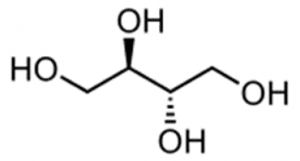Erythritol with SoPureTM Stevia
SoPure Complementary Ingredients


Blending erythritol with stevia is common in many stevia applications and found in a variety of food & beverage products. Erythritol is a sugar alcohol and low calorie sweetener that occurs naturally in certain fruits like pears, melons and grapes, as well as in mushrooms. For food and beverage product manufacturers, erythritol acts as an ideal complement to SoPureTM stevia as it provides upfront sweetness to balance out the more delayed sweetness of stevia.
Manufacturer’s Notes
- Has cooling effect at increased use level
- Does not spread as easily as sugar in baking
- Can be labeled as a natural flavor under FEMA 4819
- Beverages < 1.25%
- Other applications can refer to the FEMA site
- Beverages < 1.25%
-
- Processed commercially via fermentation
Please see the table below for FDA GRAS (Generally Regarded as Safe) levels of erythritol that have been reviewed in the US and are allowed in many other countries. Use levels above these values require supplement labeling.
|
Food Product Category from GRAS/GRN 789 |
Use Level (%) |
|
Alcoholic lite beer and coolers; Flavored quenchers; Reduced and low calorie carbonated and non-carbonated beverages (excluding soy-based drinks); Fruit-based slushies; Dairy drinks (chocolate and flavored milks); Fruit-based smoothies |
3.5% |
|
Hot cereal (oatmeal – instant or cooked) |
3% |
| Non-dairy toppings; Frozen desserts (regular ice cream, soft serve, sorbet, frozen yogurt); Puddings (instant, phosphate set); Salty snacks |
10% |
|
Baked goods and baking mixes (excluding regular bread); Bars (granola, high protein); Cookies; Barbecue sauce; Tomato sauce; Low calorie salad dressings; Fillings (fruit, custard, cream, pudding); Jams and jellies; Canned fruit (syrup); Regular or low-calorie syrups or toppings |
15% |
|
Cakes |
25% |
|
Ready-to-eat cereals |
30% |
|
Soy, almond, cashew, coconut and other plant-based drinks |
6% |
|
Yogurt (10% level allowed in GRN 74) |
5%-10% |
|
Fruit novelty snacks (e.g., fruit peel, fruit candy bar, fruit leathers, fruit creams, fruit snack candy, gummy fruits); Non-chocolate candies; Soft chocolate candies |
45% |
|
Fat-based cream used in modified-fat or low-calorie cookies, cakes and pastries |
60% |
|
Chewing gum |
75% |
|
Hard candy (mints, pressed, candies, cough drops) |
99% |
|
Sugar substitutes |
100% |
Source: FDA
Our Research, Development and Application groups in the Americas and Asia are on hand to provide more customized food and beverage formulation guidance for select customers. Starting formulas for beverages, including carbonated soft drinks and iced teas, and foods, such as yogurt and cookies, are available from the SoPureTM formulation library.
Contact us at Nascent Health Sciences to inquire about SoPureTM application support.
